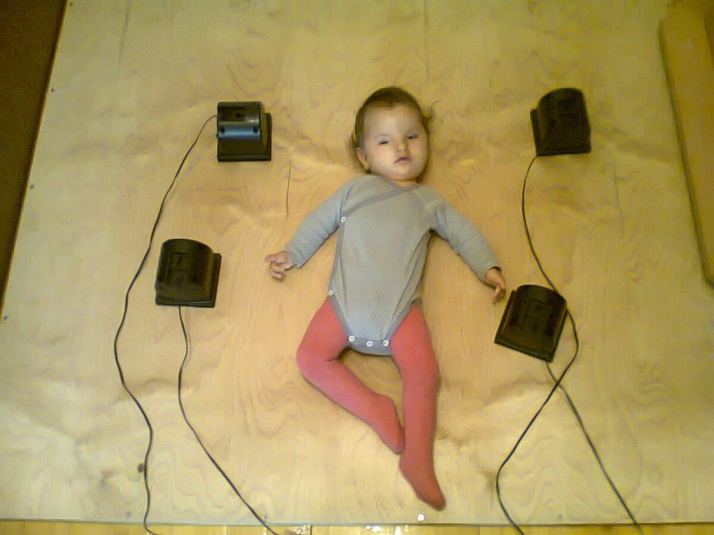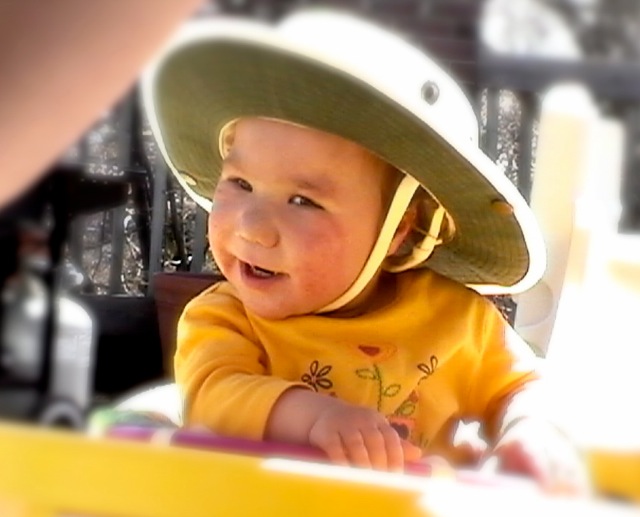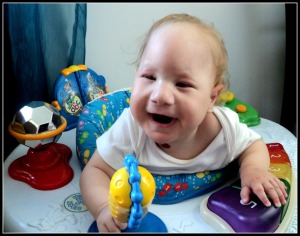Azi vreau sa v-o prezint pe Nectaria, o fetita extrem de dulce care tocmai a implinit un an si patru luni. Ea are o afectiune cromozomiala foarte rara: cromozom in inel 13 (un cromozom din perechea nr 13 a suferit o deletie-pierdere de material genetic- iar apoi a luat forma unui inel). Aceasta afectiune implica si modificari cerebrale importante. In ciuda prognosticului destul de sumbru, Nectaria traieste, infloreste si face progrese.
Din punct de vedere motor, Nectaria este pe la 3-4 luni (se rostogoleste pe lateral si uneori si pe burtica, are un control partial al capului). Face terapia vojta si elemente de terapie Anat Baniel (e vorba de relationarea intre diverse segmente ale corpului si multitudinea de miscari pe care le poate face si simti copilul; conditia este ca cel mic sa accepte pozitiile si sa fie atent astfel incat creierul lui sa receptioneze informatia). Lucreaza cu flashcards si cu programe de stimulare vizuala de pe youtube (imagini contrastante) pe care le urmareste cu interes.
Parintii i-au cumparat o palnie pentru stimularea vestibulara (Palnie de echilibru Mini Top), care ii place foarte mult:
 De asemenea, i-au construit little room– un spatiu care sa o stimuleze din mai multe puncte de vedere: se invata relatia spatiala dintre jucarii, sus fiind plexiglas, ii pun Nectariei tableta cu programe de stimulare vizuala. In plus mai are si o lampa de la Philips care schimba culorile- ii place foarte mult, iar pe pereti sunt imagini de stimulare vizuala:
De asemenea, i-au construit little room– un spatiu care sa o stimuleze din mai multe puncte de vedere: se invata relatia spatiala dintre jucarii, sus fiind plexiglas, ii pun Nectariei tableta cu programe de stimulare vizuala. In plus mai are si o lampa de la Philips care schimba culorile- ii place foarte mult, iar pe pereti sunt imagini de stimulare vizuala:

 Doamna psiholog Gabriela Jianu descrie aceasta little room ca fiind „o mică camera senzorială , care oferă copilului posibilitatea învăţării active ,prin acţiunea directă cu obiectele, care ajutăla orientarea spaţială într-un mediu limitat. Ea consta „dintr-un cadru de metal sau lemn ,3 panouri laterale şi un plafon din plexiglass din care obiectele sunt suspendate cu elastic ,astfel încât copilul să le poată apuca, iar ele sa revină la poziţia iniţială”.
Doamna psiholog Gabriela Jianu descrie aceasta little room ca fiind „o mică camera senzorială , care oferă copilului posibilitatea învăţării active ,prin acţiunea directă cu obiectele, care ajutăla orientarea spaţială într-un mediu limitat. Ea consta „dintr-un cadru de metal sau lemn ,3 panouri laterale şi un plafon din plexiglass din care obiectele sunt suspendate cu elastic ,astfel încât copilul să le poată apuca, iar ele sa revină la poziţia iniţială”.
De asemenea, Nectaria mai foloseste o placa de rezonanta:
 Placa de rezonanta este descrisa de Gabiela Jianu ca fiind- „o placă din lemn pusă pe un cadru tot din lemn. O calitate deosebită a plăcii este că orice mişcare pe suprafaţa acesteia va produce un sunet amplificat şi vibraţii. Placa de rezonanţă vibrează la muzică şi la voci ,chiar dacă sunetul nu este în contact direct cu suprafaţa de lemn. Pentru copiii cu deficienţe senzoriale multiple amplificarea sunetului este importantă ,dar perceperea vibraţiilor care însoţeşte sunetul va avea efect de stimulare imens, mai ales dacă copilul este întins pe placă”.
Placa de rezonanta este descrisa de Gabiela Jianu ca fiind- „o placă din lemn pusă pe un cadru tot din lemn. O calitate deosebită a plăcii este că orice mişcare pe suprafaţa acesteia va produce un sunet amplificat şi vibraţii. Placa de rezonanţă vibrează la muzică şi la voci ,chiar dacă sunetul nu este în contact direct cu suprafaţa de lemn. Pentru copiii cu deficienţe senzoriale multiple amplificarea sunetului este importantă ,dar perceperea vibraţiilor care însoţeşte sunetul va avea efect de stimulare imens, mai ales dacă copilul este întins pe placă”.
Aceste echipamente sunt create de dr. psiholog Lilli Nielsen din Danemarca.
Cu ajutorul acestor echipamente de stimulare, Nectaria face progrese si se dezvolta neasteptat de bine pentru diagnosticul ei.
Despre fiecare dintre aceste echipamente de terapie vrem sa povestim in detaliu in curand.
Multumim Nectariei si parintilor pentru ca au impartasit cu noi povestea lor si ceea ce au invatat pentru a o ajuta pe fetita.








